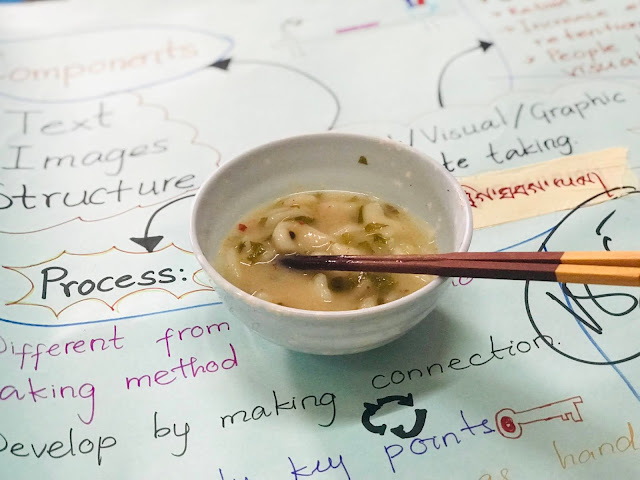“Students were able to learn concepts better than before. Chemistry became joy for my class.” Lop. Karma, chemistry teacher confesses. We can never underestimate value of small things we do differently in our classrooms. Children grow up seeing words as images, understand words through imagery and makes meaning by connecting it to its description. Every adult is a child when it comes to artistic joy of experience.
If schools can take small steps to make learning an enjoyable engagement, differently and strategically, children will be able to learn more evocatively. I always believe that ‘small things matter’ in how teachers provide creative ways, even if incrementally, when engaging students in learning processes. My teachers have begun to etch the information from meetings and talks in artistic ways, and it is the beginning of a livelier classroom.His Majesty the King decreed
within the Royal Kasho that, “In preparing our youth for the future, we must
take advantage of available technologies, adapt global best practices, and engineer a teaching-learning
environment suited to our needs.” It is a direction
for teachers to employ adaptive learning opportunities for students to learn
through varied differentiated learning models. The fervour of Visual
Note-Taking is a small measure to fulfil part of the Royal concern, by bringing
liveliness and variety in teaching methods.
Dechentsemo
Central School teachers were trained in Visual Note-taking technique on 4th
September 2021. I have learnt about the Visual note-taking strategy during the
training of School Leadership Development Programme at RIGSS in Tsirang. Visual note-taking is one of the perfect skills
for 21st century learners. It is the translation of the words or
information into recognizable pictures. This is where the student has creative space
to characterize the concepts in an artistic form. “Sir, I am surprised when
madam taught us how we can take notes artistically, and catch important
messages. This is better than writing notes from teachers.” A class VIII
students said, joyful.
What
is Visual-Note Taking?
·
It is the process of
representing information non-linguistically through drawings or pictures.
·
It can be simple using sketches or doodles or more complex using
Mind mapping or Concept Maps as representations.
· It is created in real-time while actively listening to content, typically drawn using pen and marker and can also be drawn digitally. The composition is non-linear unlike the regular mind mapping and note taking processes.
• Visual notes
are not drawn left to right and top-down like traditional notes.
• They are
developed by making connections between content.
• They use
illustration as well as handwritten text to communicate information and
represent concepts from presentations, meetings, class lectures, or anything,
really.
• This
combination of text and simple illustrations create simple “bookmarks” in the
brain.
Visual
Note-taking has been widely researched areas that demonstrate evidences of
scientific benefits for learners. This strategy aligns to multi-intelligence
learning model that cater to diversity of learners. It is known to boost
ability to process, retain, and recall information.
• Researchers
have found that color visuals increase
a person’s willingness to read by 80 percent (Green, 1989) and sixty-five
percent of people simply learn better visually (Yapton, 1998). The graduate students,
Udomon, et al., (2013) at the University of Wisconsin-Madison found that
visuals are more effective than audio at achieving higher memory retention. The
study found that participants who viewed only text remembered 10 percent of
what they read after three days.
Similar
study by Lester, (2006) found that people remembered 80 percent of what they
see, 10 percent of what they hear, and only 20 percent of what they read.
The
scientific studies attest that the brain processes visuals 60,000 times faster
than text (Semetko & Scammell, 2012). Children love images, and images when
used with colours captivate children, drawing inner curiosity to read and
engage in learning. It is often more enjoyable and enhances learning in the
classroom.
Those
who viewed text paired with visuals remembered 65 percent of the information three
days later (Medina, 2008), indicating importance, not only of taking visual
notes but also displaying visual notes for learning.In one of the recent
researches, using visuals during meetings has been found to create more and
better ideas, and increase recall capacity. (Averett, 2014).
The
Visual Note Taking Strategy is an extension of mind mapping which is designed
as an on-going activity with diagrammatic representation capturing vital learning
points. It can therefore be used for teaching, learning and even evaluating
students’ learning when in the class.
Note:
This is written to inspire other schools to emulate practices for better
learning journey.
Namgyal
Tshering
Principal,
Dechentsemo CS,







0 comments:
Post a Comment